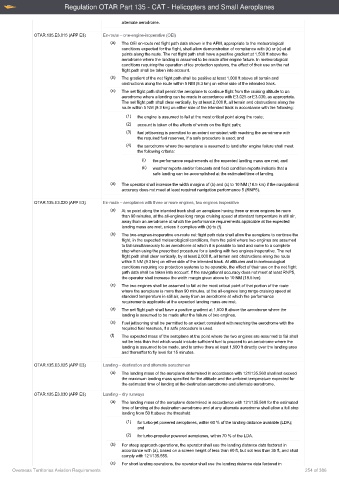Page 254 - Overseas Territories Aviation Requirements Consolidated - Total AOC
P. 254
Regulation OTAR Part 135 - CAT - Helicopters and Small Aeroplanes
alternate aerodrome.
OTAR.135.E3.015 (APP E3) En-route – one-engine-inoperative (OEI)
(a) The OEI en-route net flight path data shown in the AFM, appropriate to the meteorological
conditions expected for the flight, shall allow demonstration of compliance with (b) or (c) at all
points along the route. The net flight path shall have a positive gradient at 1,500 ft above the
aerodrome where the landing is assumed to be made after engine failure. In meteorological
conditions requiring the operation of ice protection systems, the effect of their use on the net
flight path shall be taken into account.
(b) The gradient of the net flight path shall be positive at least 1,000 ft above all terrain and
obstructions along the route within 5 NM (9.3 km) on either side of the intended track.
(c) The net flight path shall permit the aeroplane to continue flight from the cruising altitude to an
aerodrome where a landing can be made in accordance with E3.025 or E3.030, as appropriate.
The net flight path shall clear vertically, by at least 2,000 ft, all terrain and obstructions along the
route within 5 NM (9.3 km) on either side of the intended track in accordance with the following:
(1) the engine is assumed to fail at the most critical point along the route;
(2) account is taken of the effects of winds on the flight path;
(3) fuel jettisoning is permitted to an extent consistent with reaching the aerodrome with
the required fuel reserves, if a safe procedure is used; and
(4) the aerodrome where the aeroplane is assumed to land after engine failure shall meet
the following criteria:
(i) the performance requirements at the expected landing mass are met; and
(ii) weather reports and/or forecasts and field condition reports indicate that a
safe landing can be accomplished at the estimated time of landing.
(d) The operator shall increase the width margins of (b) and (c) to 10 NM (18.5 km) if the navigational
accuracy does not meet at least required navigation performance 5 (RNP5).
OTAR.135.E3.020 (APP E3) En-route – aeroplanes with three or more engines, two engines inoperative
(a) At no point along the intended track shall an aeroplane having three or more engines be more
than 90 minutes, at the all-engines long range cruising speed at standard temperature in still air,
away from an aerodrome at which the performance requirements applicable at the expected
landing mass are met, unless it complies with (b) to (f).
(b) The two-engines-inoperative en-route net flight path data shall allow the aeroplane to continue the
flight, in the expected meteorological conditions, from the point where two engines are assumed
to fail simultaneously to an aerodrome at which it is possible to land and come to a complete
stop when using the prescribed procedure for a landing with two engines inoperative. The net
flight path shall clear vertically, by at least 2,000 ft, all terrain and obstructions along the route
within 5 NM (9.3 km) on either side of the intended track. At altitudes and in meteorological
conditions requiring ice protection systems to be operable, the effect of their use on the net flight
path data shall be taken into account. If the navigational accuracy does not meet at least RNP5,
the operator shall increase the width margin given above to 10 NM (18.5 km).
(c) The two engines shall be assumed to fail at the most critical point of that portion of the route
where the aeroplane is more than 90 minutes, at the all-engines long range cruising speed at
standard temperature in still air, away from an aerodrome at which the performance
requirements applicable at the expected landing mass are met.
(d) The net flight path shall have a positive gradient at 1,500 ft above the aerodrome where the
landing is assumed to be made after the failure of two engines.
(e) Fuel jettisoning shall be permitted to an extent consistent with reaching the aerodrome with the
required fuel reserves, if a safe procedure is used.
(f) The expected mass of the aeroplane at the point where the two engines are assumed to fail shall
not be less than that which would include sufficient fuel to proceed to an aerodrome where the
landing is assumed to be made, and to arrive there at least 1,500 ft directly over the landing area
and thereafter to fly level for 15 minutes.
OTAR.135.E3.025 (APP E3) Landing – destination and alternate aerodromes
(a) The landing mass of the aeroplane determined in accordance with 121/135.560 shall not exceed
the maximum landing mass specified for the altitude and the ambient temperature expected for
the estimated time of landing at the destination aerodrome and alternate aerodrome.
OTAR.135.E3.030 (APP E3) Landing – dry runways
(a) The landing mass of the aeroplane determined in accordance with 121/135.560 for the estimated
time of landing at the destination aerodrome and at any alternate aerodrome shall allow a full stop
landing from 50 ft above the threshold:
(1) for turbo-jet powered aeroplanes, within 60 % of the landing distance available (LDA);
and
(2) for turbo-propeller powered aeroplanes, within 70 % of the LDA.
(b) For steep approach operations, the operator shall use the landing distance data factored in
accordance with (a), based on a screen height of less than 60 ft, but not less than 35 ft, and shall
comply with 121/135.555.
(c) For short landing operations, the operator shall use the landing distance data factored in
Overseas Territories Aviation Requirements 254 of 386

